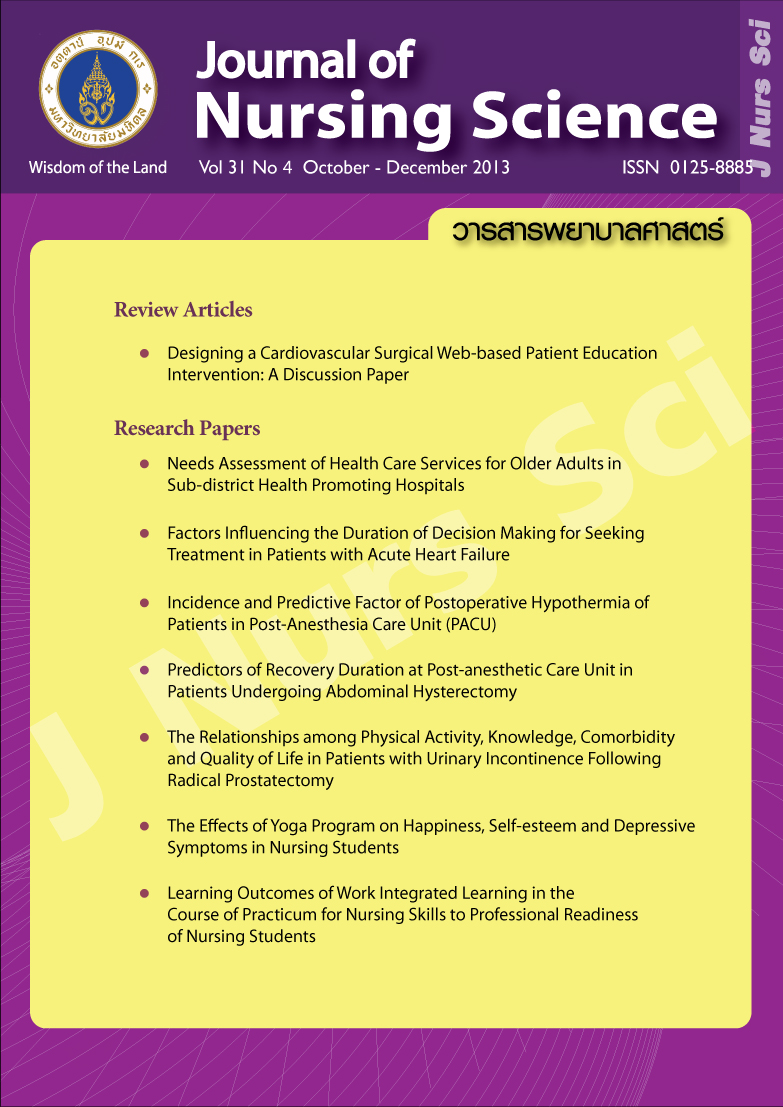Factors Influencing the Duration of Decision Making for Seeking Treatment in Patients with Acute Heart Failure
Main Article Content
Abstract
Purpose: The objective of this study was to explore the factors influencing the duration of decision making in seeking treatment for heart failure at hospital. Influencing factors include cognitive illness representation (identity, timeline, personal/treatment control, and consequences) and emotional illness representation.
Design: Predictive research design.
Methods: The study questioned 98 patients with acute heart failure, who were conveniently available as inpatients at tertiary hospital in Bangkok. The data were collected by using two questionnaires: the demographic data and the Brief Illness Perception Questionnaire (Brief IPQ). The data were analyzed using descriptive statistics, including frequency, percentage, range, mean, median, standard deviation and multiple regression analysis.
Main findings: The average duration of decision making for seeking treatment in hospital was 14 hours and 30 minutes, ranging from 0 minute to nearly 3 days, with a median of 6 hours. In multiple regression analysis, it was found that cognitive illness representation and emotional illness representation could jointly predict the duration of decision making for seeking treatment in hospital for 53%. The factors of identity, personal/treatment control and consequences were found to be significant predictors of the duration of decision making for seeking treatment in hospital (p < .01).
Conclusion and recommendations: Nurses should provide information for patients and their families before discharge, regarding how to recognize the significant signs and symptoms of acute heart failure, and encourage earlier treatment seeking. In addition, nurses should teach patients and their families how to monitor and manage some heart failure symptoms to reduce potential harms from acute heart failure.
ปัจจัยที่มีอิทธิพลต่อระยะเวลาในการตัดสินใจมารับการรักษาในผู้ป่วยภาวะหัวใจล้มเหลวเฉียบพลัน
ปิโยรส เกษตรกาลาม์, ดวงรัตน์ วัฒนกิจไกรเลิศ, วิชชุดา เจริญกิจการ, ศรินรัตน์ ศรีประสงค์, ฉัตรกนก ทุมวิภาต
บทคัดย่อ
วัตถุประสงค์: เพื่อศึกษาระยะเวลาในการตัดสินใจมารับการรักษาและปัจจัยที่มีอิทธิพลต่อระยะเวลาในการตัดสินใจมารับการรักษา ได้แก่ ปัจจัยด้านการรับรู้ความเจ็บป่วย (ด้านการรับรู้อาการ ด้านระยะเวลา ด้านการควบคุมหรือรักษาความเจ็บป่วย ด้านผลที่เกิดตามมา) และการตอบสนองทางอารมณ์ต่อความเจ็บป่วยของผู้ป่วยภาวะหัวใจล้มเหลวเฉียบพลัน
รูปแบบการวิจัย: การศึกษาความสัมพันธ์เชิงทำนาย
วิธีดำเนินการวิจัย: กลุ่มตัวอย่างเป็นผู้ป่วยภาวะหัวใจล้มเหลวเฉียบพลันที่เข้ารับการรักษาเป็นผู้ป่วยในที่โรงพยาบาลตติยภูมิแห่งหนึ่งในกรุงเทพมหานคร จำนวน 98 ราย เก็บรวบรวมข้อมูลโดยใช้แบบสอบถามทั้งหมด 2 ส่วนได้แก่ ส่วนที่ 1 แบบบันทึกข้อมูลพื้นฐานของผู้ป่วย และส่วนที่ 2 แบบสอบถามการรับรู้เกี่ยวกับความเจ็บป่วยฉบับย่อ (Brief IPQ) การวิเคราะห์ข้อมูลโดยใช้ความถี่ ร้อยละ ค่าพิสัย ค่าเฉลี่ย ค่ามัธยฐาน และส่วนเบี่ยงเบนมาตรฐาน และการวิเคราะห์ถดถอยแบบเส้นตรงพหุคูณ
ผลการวิจัย: ค่าเฉลี่ยของระยะเวลาตั้งแต่เกิดอาการของภาวะหัวใจล้มเหลวที่รุนแรงขึ้นจนตัดสินใจมารับการรักษาในโรงพยาบาลเท่ากับ 14 ชั่วโมง 30 นาที ขณะที่ค่ามัธยฐานเท่ากับ 6 ชั่วโมง (ค่าต่ำสุด = 0 นาที, ค่าสูงสุด = 2 วัน 23 ชั่วโมง 30 นาที) และพบว่าการรับรู้ความเจ็บป่วย และการตอบสนองทางอารมณ์ต่อความเจ็บป่วยร่วมกันทำนายระยะเวลาในการตัดสินใจมารับการรักษาของผู้ป่วยภาวะหัวใจล้มเหลวเฉียบพลันได้ร้อยละ 53 โดยการรับรู้ความเจ็บป่วยด้านการรับรู้อาการ ด้านการควบคุมหรือรักษาความเจ็บป่วย และด้านผลที่เกิดตามมาสามารถทำนายระยะเวลาในการตัดสินใจมารับการรักษาของผู้ป่วยภาวะหัวใจล้มเหลวเฉียบพลันได้อย่างมีนัยสำคัญทางสถิติ (p < .01)
สรุปและข้อเสนอแนะ: พยาบาลควรให้ข้อมูลแก่ผู้ป่วยและครอบครัวก่อนการจำหน่าย โดยเน้นให้เห็นความสำคัญของอาการ และอาการแสดงของภาวะหัวใจล้มเหลวเฉียบพลันที่ต้องมารับการรักษาทันที และผลที่ตามมาจากการมารับการรักษาล่าช้า เพื่อลดระยะเวลาในการตัดสินใจมารับการรักษาที่โรงพยาบาล รวมทั้งการควบคุมและรักษาภาวะหัวใจล้มเหลวในชีวิตประจำวัน เพื่อลดการเกิดภาวะหัวใจล้มเหลวเฉียบพลัน
คำสำคัญ: ภาวะหัวใจล้มเหลวเฉียบพลัน การตัดสินใจมารับการรักษา การรับรู้ความเจ็บป่วย
Article Details
Copyright Notice: Nursing Science Journal of Thailand has exclusive rights to publish and distribute the manuscript and all contents therein. Without the journal’s permission, the dissemination of the manuscript in another journal or online, and the reproduction of the manuscript for non-educational purpose are prohibited.

Disclaimer: The opinion expressed and figures provided in this journal, NSJT, are the sole responsibility of the authors. The editorial board bears no responsibility in this regard.

